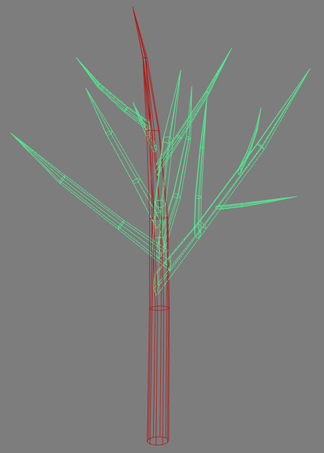The BRAWL² Tournament Challenge has been announced!
It starts May 12, and ends Oct 17. Let's see what you got!
https://polycount.com/discussion/237047/the-brawl²-tournament
It starts May 12, and ends Oct 17. Let's see what you got!
https://polycount.com/discussion/237047/the-brawl²-tournament


Replies
The question is "how close will a player get?"
Probably not close enough that it will matter.
I would go for one mesh as well just because the seams are probably easier to control this way, and you can get much better organic shapes, especially where the branches meet the trunk.
If joining every branch means your tree geometry is going to shoot up significantly while not providing the silhouette with a smoother shape then you've failed to use those polys effectively. Instead of blindly following a rule that someone tosses out, think about what is the best way to pull off the most detail with the least amount of resources in the time you have, and do it that way. If you can get more detail by joining everything AND you have the time to do it, have fun go nuts. But if it will be easier to unwrap each piece if they are separate and the detail won't take a hit then save yourself some time for something that someone is more apt to look at.
With this model you have enough polys to join every branch to the trunk while keeping the same poly count you currently have. BUT only because you made every branch as round as possible by over modeling their thickness. If you trimmed them down to 3-4-5 sided cylinders and didn't join them you could do much more, put in more bends in each branch, add more branches and leaves, make a little birds nest, create a stranded kite maybe even make a tree fort. You also have to worry about the joints that are created when you join everything and what those joints will do to the lighting. Often all you get for your joining effort is a chunked up your poly count and misshapen joints. If it takes 200 polys and 4hrs to join everything thats 200 polys and 4hrs of leaves you could use to really fill out the tree.
I know right now time might not seam like a concern but when you're given a list of 20 props to make in 3 days, sitting there welding and joining every last branch is going to seam pretty insane.
You might be able to get better results if you join everything but ask yourself this:
1) Do I have the time to align, cut, weld and unwrap all those branches?
2) Is it really going to increase the detail or is it just a waste of time and resources?
[ QUOTE ]
But the real question is: how will the engine handle it? I know that at least some engines used to screw up lighting when things were done this way; if the verts where inside something, the lighting could really screw up those first (intersected) polys, as those verts would be 'in the dark' (no light inside that other mesh). So do current engines handle that better?
[/ QUOTE ]I think the proper question is are artist smarter now and better at handling the issue. The engine you talk about is running on vertex lighting and deals with long polys that have verts inside of a dark area. To get around this you can either not put the verts in a dark area OR Place a ring of verts just outside the mesh so those verts will catch light and light the rest of the branch correctly while a small part of the branch by the trunk is lite darkly, kind of faking some AO which can be a nice effect. You can also minimize the amounts of verts hidden inside the tree, saving yourself polys, verts and time.
So quick recap. It depends on what engine, what time you have, and what will get you the best results with the least resources. You won't find a "pros do it this way and only this way" answer to a question like this. What you will find is that pros ask questions and take the grand scope of the game into account when considering how to build something.
Vig: Awesome. This is the kind of response I was looking for, without knowing it. I see your point about time vs. resources over technique. I hate asking noob questions like this, but how else do you learn, eh?
http://www.scriptspot.com/3ds-max/tree-maker
but how else do you learn, eh?
[/ QUOTE ]
Exactly. So don't worry about asking, chances are because you took a chance and asked you answered someone else's questions also.
I would stay away from the make tree button until you have a few quality trees made on your own. Its a great script at making very particular trees. I use it all the time but I choose to do the leave planes myself. I didn't want to mention it because its too easy to relay on but since the cats out of the bag... If you're in the mood to use tree maker programs check these out.
http://www.onyxtree.com/stormx.html
http://www.bionatics.com/
http://www.speedtree.com/
http://www.treegenerator.com/
http://graphics.uni-konstanz.de/~luft/ivy_generator/ <-Ivy generator
http://www.guruware.at/main/ivy/index.html <- 3ds Max script based on the program above
I'm sure there are more out there, these are the ones I remember off the top of my head.
Remember, if you end up switching 3D apps you can't take the script with you and some places might not want to put down extra money for your "amazing tree generating skills" ie program... But if you know how to approach making trees you'll be in a good position to just roll on along.
http://ngplant.sourceforge.net/